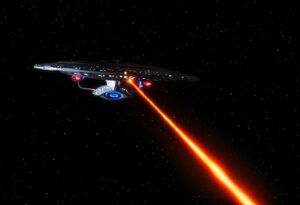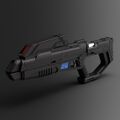Phasers: Difference between revisions
More actions
CrimsonTacit (talk | contribs) No edit summary |
CrimsonTacit (talk | contribs) mNo edit summary |
||
| Line 116: | Line 116: | ||
*Ships wouldn't normally carry these, but they could be fabricated as-needed for specific missions. | *Ships wouldn't normally carry these, but they could be fabricated as-needed for specific missions. | ||
=== | === Starship and Small Craft Phasers === | ||
====Phaser Banks==== | ====Phaser Banks==== | ||
| Line 151: | Line 151: | ||
*These cannons are very powerful but take an extremely long amount of time to recharge, meaning that they must be fired very strategically, as the ship must rely on its conventional phasers while the cannon recharges if it doesn't take the enemy out in the first shot. | *These cannons are very powerful but take an extremely long amount of time to recharge, meaning that they must be fired very strategically, as the ship must rely on its conventional phasers while the cannon recharges if it doesn't take the enemy out in the first shot. | ||
==Starbase & Planetary Defense Phasers== | ====Starbase & Planetary Defense Phasers==== | ||
==Phasers In Play== | ==Phasers In Play== | ||
Revision as of 00:34, 17 February 2021

Phaser Types and Form Factors
Phasers are classified both by their type rating (which is their theoretical maximum energy output) and their form factor (which is the type of device or implement they are constructed as). Their actual output is dependent on the power available to them; for instance, the benefit of employing a higher type of array than a vessel could comfortably use at full power is to increase reliability and fleet standardization. The increase in power between various phaser types is not equal across the scale due to the idiosyncratic properties of nadion fields, which makes some types uneconomical to use.
While there are numerous types and form factors, phasers can be broken down into two larger styles: standard and compression, based on how their focusing crystals are arranged. Standard phasers (such as hand phasers and phaser arrays) use a single crystal to produce their beams, while compression phasers (such as phaser rifles and phaser cannons) have a barrel containing multiple crystals arranged to improve the coherence and range of the beam and to avoid attenuation.
| Type | Maximum Theoretical Output |
|---|---|
| Type-I | 0.005MW |
| Type-II | 0.01MW |
| Type-III | 0.02MW |
| Type-IV | 0.1MW |
| Type-V | 0.5MW |
| Type-VI | 1.5MW |
| Type-VII | 2MW |
| Type-VIII | 2.5MW |
| Type-IX | 3MW |
| Type-X | 5.1MW |
| Type-XI | 6MW |
| Type-XII | 8MW |
| Type-XIII | 9MW |
| Type-XIV | 10MW |
| Type-XV | 12MW |
Note: The maximum output for each phaser type is the theoretical limit at which the nadion field would collapse and the phaser would begin to damage itself, but the maximum output is dependent on a sufficient power supply. That is to say that a Type-X phaser on an Intrepid-class light explorer will be substantially less powerful than one on a Galaxy-class explorer because of the difference in their power plants.
Common Starfleet Phasers
Theoretically, most output classifications could be built in any form factor (i.e. one could build a Type-XV phaser rifle if one had a strong enough power source, or a Type-I phaser array if one had a use for it), though Starfleet typically uses just a few combinations of forn factor and output types. The most common phasers in use as of 2399 are:
- Type-VI Phaser Banks: Employed aboard starships in the 2250s such as the Constitution-class. Generally in double ball turret emplacements.
- Type-VII Phaser Banks: Introduced in the 2270s on the Miranda-class refit. Generally in double ball turret emplacements
- Type-VIII: Introduced in the 2290s on the Excelsior-class. Generally in double ball turret emplacements
- Type-IX: Introduced in the 2330s on the Ambassador-class. First phaser type to be built as an array.
Portable Phasers
Standard Personal Phasers
Personal phasers are most commonly-issued weapons given to Starfleet personnel, and they are used for a wide range of purposes in defensive and exploratory applications. They are easy to use, sophisticated, and reliable.
Type-I & II Hand Phasers
Hand phasers are the most common types of phasers issued to Starfleet personnel, aboard ships and starbases, and for planetside duty. They are versatile, easy to operate, and highly portable, with most humanoids being able to operate them with just one hand. Starfleet hand phasers come in type-I and type-II versions, with the type-II version being the standard side-arm for nearly every situation; the type-I is generally only used when discretion about being armed is desired. Modern hand phasers can emit either bolts or coherent beams of energy, depending on the needs of the mission. Their settings range from Level 1 (Light Stun) to Level 10 (Kill) to Level 16 (Vaporize).
Early hand phasers closely resembled earlier types of weapons such as projectile-firing pistols, but by the 2350s, phasers were generally shaped less-obviously like a weapon and consisted of a long handle that curved down to the emitter point. The firing trigger is on the top of the device. By 2385, pistol-style hand phasers have been reintroduced to Starfleet, and both types continue to be produced.
These are the three most common models of hand phaser in service with Starfleet as of 2399, the Type-I and Type-II models introduced in the late 2370s that continue to be common across the fleet, and the newer 2385-era Type-II phaser pistol:
-
The Type-I hand phaser
In-Play
- To a member of Starfleet, a hand phaser is more than just a weapon: it's a tool of near-infinite utility. As mentioned above, the ability to set its energy output makes it useful for all manner of tasks, and on many exploratory, scientific, and engineering missions, it's just as likely to be used for constructive purposes as it is for defense.
- While the Type-I phaser was common in TOS and in early episodes of TNG, it hasn't been seen in recent iterations of Star Trek. That doesn't mean your character wouldn't have a use for one of these smaller devices; they might be carried concealed by security officers during diplomatic missions, or be stashed in a medical kit by a doctor who expects trouble on an away mission.
Type-III Phaser Rifle
Phaser rifles are larger than hand phasers and are generally the heaviest personal weapons stocked aboard most Federation starships. While they have the same sixteen settings as their smaller counterparts, their power cells allow them to fire more quickly, for longer periods of time, and at longer range, which makes them well-suited to extended firefights. Generally speaking, A phaser rifle can fire twice as many shots twice as far as a hand phaser, in either bursts or coherent beams. They are only commonly used when combat is anticipated, and are not standard away team equipment.
These are the two most common phaser rifles in Starfleet service: a model introduced in the late 2370s and a ruggedized version developed in the late 2380s:
In-Play
- Many Starfleet officers would only have used phaser rifles in training scenarios and would find them a little unwieldy in the field, especially science officers and engineers. They're not commonly used during most Starfleet missions. Indeed, Gene Roddenberry only allowed the phaser rifle to be used once in TOS because he found it to be too militaristic.
- Phaser rifles can mount scopes, sensors, and lights, which can help their users find their way in the dark or in low-light conditions.
- Phaser rifles wouldn't be stocked at all on civilian ships or medical ships.
Specialized Portable Phasers
There are other types of phasers that Starfleet personnel use in the field which are too large to be used while carried and which have specific defensive or utility purposes.
Type-III Phaser Drill
Type-III phaser drills are tools with the same overall output potential as a phaser rifle, but with a ruggedized emitter, larger power source, and the ability to fire for sustained periods of time—up to several dozen hours at a time—before they need to be swapped out. This makes them capable of creating large passageways through solid rock, cutting through dense metal, and other such tasks. They can be aimed, fired, and then left to work without needing an operator constantly present, and they are substantially more ergonomic for drilling operations than hand phasers. They also have finer control over their beams to provide precisely the frequency and power level to cut through a particular material without causing unwanted damage or disruption effects. These are commonly stocked aboard almost every Federation starship that's expected to conduct planetary exploration missions and don't require specialized training to operate in their most basic settings.
-
A pair of phaser drills.
In-Play
- Phaser drills do exactly what their name suggests: they're used for excavating large amounts of material quickly. They can be used for all sorts of missions including mining prospecting, archaeological digs, spelunking, salvage operations, and other non-combat tasks.
- A phaser drill is still a phaser, so if it was your last resort, you could use it in a defensive way—it would not be fun to be on the receiving end of a blast from a tool meant to cut through solid rock or duranium. These boxy tools would be very hard to aim like a weapon, though.
Type-IV Phaser Cannon
Type-IV phaser cannons are too large to be carried and fired by hand and must be mounted on a tripod or to a vehicle, such as an Argo-type wheeled ground vehicle. These weapons are aimed and fired by a crew member who must turn them manually. Assisted targeting obviates the need for a complex scope and keeps their operation simple. These weapons are more common in colonial defense and dedicated tactical contexts than on most standard Starfleet vessels or starbases, but their size inherently makes them a defensive weapon, as they are too large to be brought along by most away teams.
-
A Type-IV phaser cannon on the back of an Argo-type ground vehicle.
In-Play
- This is the big gun that gave Worf such a good time in Star Trek: Nemesis mounted to the back of the Argo vehicle. It's a more powerful version of the phaser rifle, but it's much less versatile and portable. Other than being mounted on similar vehicles, most Starfleet personnel wouldn't encounter them very often.
- This weapon could also be mounted on a tripod or at a fixed position on a building, or installed into a fully-automated turret, but Starfleet doesn't tend to fortify its installations the same way that other powers do: a colony is much more likely to have a very powerful shield than a set of Type-IV phaser cannon installations, but far from home colonists might have to improvise.
- Ships wouldn't normally carry these, but they could be fabricated as-needed for specific missions.
Starship and Small Craft Phasers
Phaser Banks
Phaser banks uncommon in the late 24th century, but were the standard design used in Starfleet from the early 2200s until the 2330s. Now, they are most common on minor space stations and small craft like fighters.
Type-IV & V Phaser Banks
Type-VIII Phaser Bank
Phaser Arrays
Type-VI Phaser Array
Type-IX Phaser Array
Type-X Phaser Array
Type-XII Phaser Array
Phaser Cannons
Type-VIII & IX Phaser Cannons
Type-XII Pulse Phaser Cannon
Type-XV Phaser Cannon
The Type-XV phaser canon is a unique weapon designed exclusively for the twelve so-called Dreadnought-class starships based on the Galaxy spaceframe. Intended as a "Borg Buster," this weapon can deliver an extremely high amount of energy in a fixed direction, meant to overwhelm a Borg vessel's defenses before it can adapt. This is the most powerful weapon ever mounted on a Starfleet vessel, and in practice, it can cause significant damage to most known threat vessels.
In-Play
- No member-available starship has a Type-XV phaser cannon; they're exclusively found on the Galaxy-class Refit, aka the Dreadnought-class. You might encounter one as an NPC ship or a ship in a campaign or other type of event.
- These cannons are very powerful but take an extremely long amount of time to recharge, meaning that they must be fired very strategically, as the ship must rely on its conventional phasers while the cannon recharges if it doesn't take the enemy out in the first shot.
Starbase & Planetary Defense Phasers
Phasers In Play
- Phasers have been a feature of Star Trek (other than the original pilot) since the beginning of the franchise. The hallmark of this iconic energy weapon is the ability for the user to select the power being used: it can do everything from heat rocks for warmth to stun an enemy to vaporizing large amounts of matter.
- Compared to disruptors and polaron-based weaponry, phasers are less powerful, but they are much more controllable and reliable.
- There's a reason the majority of the time we've seen Starfleet officers fighting that they haven't been toting huge weapons: Starfleet is not a military force. In rare instances where more serious weapons are required, characters would be very surprised to see them in the field.
- Hand phasers and phaser rifles vary from assignment to assignment; starships sticking close to home and minor bases are unlikely to have the best and newest equipment, and some ships will have bespoke designs based on the needs of their mission and the physiology of their crew, but all Starfleet phaser types share basic design features such as a very simple firing mechanism, adjustable power levels, and assisted targetting.
- Starship-based phasers have similar qualities to their smaller cousins; the reason Starfleet favors this weapon is for its versatility, not its brute force. They can also be used for scientific and engineering purposes, just like smaller models.









